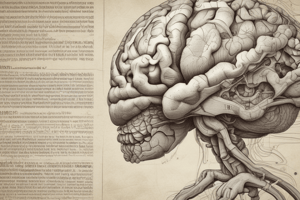Podcast
Questions and Answers
What are the three main parts of the brain?
What are the three main parts of the brain?
The three main parts of the brain are the hindbrain, midbrain, and forebrain.
What is the main function of the cerebellum?
What is the main function of the cerebellum?
The cerebellum helps to control posture, balance, and voluntary movements.
What role does the pons play in the brain?
What role does the pons play in the brain?
The pons acts as a bridge between the spinal cord and the brain and is involved in producing chemicals necessary for sleep.
What is the function of the thalamus in the brain?
What is the function of the thalamus in the brain?
What is the primary function of the hypothalamus?
What is the primary function of the hypothalamus?
What is the function of the hypothalamus in the limbic system?
What is the function of the hypothalamus in the limbic system?
What is the role of the somatosensory cortex in the brain?
What is the role of the somatosensory cortex in the brain?
What is the function of the frontal lobe in the brain?
What is the function of the frontal lobe in the brain?
What is the significance of the cerebral cortex in the brain?
What is the significance of the cerebral cortex in the brain?
What is the consequence of damage to the hippocampus?
What is the consequence of damage to the hippocampus?
Flashcards are hidden until you start studying
Study Notes
Brain Structure
- The brain is composed of three main parts: hindbrain, midbrain, and forebrain
- The hindbrain is located at the rear base of the skull and is involved in basic life processes
- The hindbrain includes the cerebellum, medulla, and pons
- The cerebellum helps control posture, balance, and voluntary movements
- The medulla controls breathing, heart rate, and various reflexes
- The pons functions as a bridge between the spinal cord and brain and produces chemicals for sleep
Midbrain
- The midbrain is a small part of the brain above the pons that integrates sensory information
- The medulla, pons, and midbrain compose most of the brain stem
- The reticular activating system (RAS) spans across these structures, alerting the brain to incoming signals and involved in the sleep/wake cycle
Forebrain
- The forebrain covers the brain's central core and includes the thalamus, which integrates sensory input
- The thalamus is a relay station for sensory information to the cortex
- All sensory information except smell enters the thalamus and is sent to the appropriate areas in the cortex
- The hypothalamus controls functions such as hunger, thirst, and sexual behavior, as well as body temperature reactions
Higher Thinking Processes
- The cerebral cortex and cerebrum surround the hindbrain and brain stem
- The cerebral cortex gives the ability to learn, store complex information, and project thinking into the future
- The cortex is the site of conscious thinking processes and is less than one-fourth inch thick
Limbic System
- The limbic system is composed of structures that regulate emotions and motivations
- The limbic system includes the hypothalamus, amygdala, thalamus, and hippocampus
- The amygdala controls violent emotions such as rage and fear
- The hippocampus is important for forming new memories
Brain Lobes
- The cerebrum is divided into two hemispheres, connected by the corpus callosum
- Each hemisphere has deep grooves marking regions or lobes
- The occipital lobe processes visual signals, and damage can cause visual problems
- The parietal lobe is concerned with sensory information from the body
- The temporal lobe is concerned with hearing, memory, emotion, and speaking
- The frontal lobe is concerned with organization, planning, and creative thinking
Studying That Suits You
Use AI to generate personalized quizzes and flashcards to suit your learning preferences.



